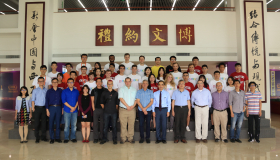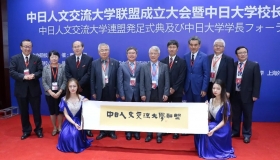Professor Arieh Warshel, the 2013 Nobel Laureate in Chemistry: pleased with development of the Institute and Recognized the Chinese University of Hong Kong, Shenzhen's English-medium Education as a Way for Science without Boundaries
Established in 2017, Warshel Institute of Computational Biology of The Chinese University of Hong Kong, Shenzhen, led by Professor Arieh Warshel, Nobel Laureate in Chemistry 2013, has ushered in fruitful results in 2019, with a body of quality research beginning to flourish.
Recently, Professor Warshel has, once again, arrived at Shenzhen to explore academic problems with his team members. He stays in Shenzhen for about one month every year to communicate with the team and participate in project discussion. He is also familiar with the research progress of the Institute.
20 Important Papers Published, Co-Executive Director Listed as “Highly Cited Scientist”
Looking back on the development of Warshel Institute of Computational Biology in the past two years, Professor Warshel is pleased with the current research results. “This year, our team moved into the new research building with better facilities and equipment. In addition, the team has grown to more than 50 members, including 6 professors, 2 researchers, 3 associate researchers, 15 post-docs and over 10 Ph.D. students and research assistants. More importantly, the results are fruitful and the researchers are very active. Many high-quality papers have been published in top journals such as Nature Communication.”
It is reported that members of the Institute have published 20 important papers in 2019, many of which were in Nature Communications, Nucleic Acids Research, Chemical Communications, and other well-known journals.
Fields of the papers include genomic informatics, structural biology, computational chemistry, multi-scale molecular simulation, etc. From January 2018 to October 2019, the team published dozens of SCI papers, some of which ranked in the top 5% in Journal Citation Reports (Area 1 of Chinese Academy of Sciences). These papers are also widely cited by scientists all over the world.
Days ago, the list of “Highly Cited Scientists” in 2019 was announced, and Professor Huang Hsien-Da, Co-Executive Director of the Institute and professor of School of Life and Health Sciences, was named.
Using Modern Technology to Break the Bottlenecks
“We are trying to deal with today's challenges in different ways. One of the major problems is biological resistance. Antibiotics were useful in the past, but now they are failing. I encourage researchers here to use big data to solve this problem, that is, using computer modeling.”
When talking about the difficulties faced by the development of drugs today, Professor Warshel said that the Institute will explore new biomarkers, carry out drug development and further biological mechanisms through modern scientific and technological means such as big data, AI and machine learning, which will also be the trend of computational biology.
With the goal of becoming a world-class theoretical computational biology center, the Institute is committed to interdisciplinary research and achievement conversion, focusing on computational structural biology, high-throughput biology and bioinformatics. It also aims at cultivating talents in bioinformatics and systems biology with both theory and application.
Computational structural biology covers protein engineering, protein structure prediction and activity improvement, exploration of enzyme catalytic reaction mechanism and enzyme design, simulation of protein and nucleic acid functional conformation changes, computer-aided drug design, and development of corresponding algorithms and software, etc.
CUHK-Shenzhen Adopts English-medium Education to Achieve Science beyond Boundaries
“In the past few days, I have also had the opportunity to participate in three seminars, all of which are high-quality academic conferences. Students asked good questions and are enthusiastic in this field. I am happy to talk to them.”
In addition to scientific research and discussion with members of the Institute, Professor Warshel also communicate with students at CUHK-Shenzhen and tell about his stories and experiences. He is impressed with the language ability of the students.
“My team members are from different countries, including India, China, Poland, Hungary, Israel and so on. It is very international. I think the strength of this University is that the students, even undergraduates, are taught in English. It is important to be able to communicate in English in academia. I found it comfortable to talk with the students.
An international team is never a so-called obstacle because science has no borders.”Professor Warshel hopes that through exchange and communication, more excellent students from CUHK-Shenzhen will join his team and become international research talents.




